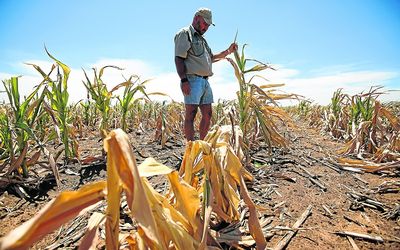Global harvests wilt in droughts and heat waves
by Nicholas St Fleur,
2016-01-11 05:53:36.0
DROUGHTS and heat waves wiped out nearly a tenth of the rice, wheat, maize and other cereal crops in countries hit by extreme weather disasters between 1964 and 2007, according to a new study.
The paper, published last week in Nature, examined data on the effects, over five decades, of extreme temperatures, floods and droughts on national crop harvests.
"People already knew that these extreme weather events had impacts on crop production," says Navin Ramankutty, a geographer from the University of British Columbia and an author of the report. "But we didn’t know by how much, and we didn’t have a basis for how that might change in the future."
Ramankutty and his team combined data from a disaster database with food production information from the United Nations Food and Agriculture Organisation. They looked at about 2,800 weather disasters, such as the 1983-84 drought in Ethiopia and the 2003 European heat wave, along with data on 16 different cereals including oats, barley, rye and maize, grown in 177 countries.
They found that droughts cut a country’s crop production by 10%, and heat waves by 9%, but that floods and cold spells had no effects on agricultural production levels. His team estimates a loss of more than 3-billion tonnes of cereal production from 1964 to 2007 as a result of droughts and heat waves.
"We don’t think about it much, but rice, wheat and maize alone provide more than 50% of global calories," says Ramankutty. "When these grain baskets are hit, it results in food price shocks, which leads to increasing hunger."
As the global population soars, food production will need to increase to feed the extra mouths. But if the world is to meet those demands, it must do so efficiently and sustainably, says Pedram Rowhani, a land-change scientist from the University of Sussex in Brighton, England, and another of the study’s authors.
"By losing 10% of our production, we’re emitting greenhouse gases and using water, oil, energy and land for nothing and not feeding anybody with it," he said. "We need to reduce that so we can feed more people and become more sustainable."
The team also found that the effects of droughts were more severe for crops produced in developed countries than in underdeveloped countries. Dry spells caused losses of nearly 20% in North America, Europe and the Australasia region, but only 12% in Asia and 9% in Africa. They found no significant effects from droughts in Latin America.
Rowhani says one reason for the discrepancy is that developed nations tend to grow more uniform crops that may be more vulnerable to drought, while underdeveloped countries grow diverse patches of plants that may have greater resilience.
The team also found that droughts occurring since 1985 were more severe than earlier ones, causing average losses of about 14% compared with about 7%. They suggest that climate change may affect the frequency and severity of these events in the future. But they say they were unable to discern whether the increase could be the result of droughts becoming more severe, or earlier data sets being more limited.
New York Times

LOSS: A Lichtenburg farmer looks at his mielies. Extreme weather leads to food price shocks and increased hunger follows. Picture: SUNDAY TIMES
DROUGHTS and heat waves wiped out nearly a tenth of the rice, wheat, maize and other cereal crops in countries hit by extreme weather disasters between 1964 and 2007, according to a new study.
The paper, published last week in Nature, examined data on the effects, over five decades, of extreme temperatures, floods and droughts on national crop harvests.
"People already knew that these extreme weather events had impacts on crop production," says Navin Ramankutty, a geographer from the University of British Columbia and an author of the report. "But we didn’t know by how much, and we didn’t have a basis for how that might change in the future."
Ramankutty and his team combined data from a disaster database with food production information from the United Nations Food and Agriculture Organisation. They looked at about 2,800 weather disasters, such as the 1983-84 drought in Ethiopia and the 2003 European heat wave, along with data on 16 different cereals including oats, barley, rye and maize, grown in 177 countries.
They found that droughts cut a country’s crop production by 10%, and heat waves by 9%, but that floods and cold spells had no effects on agricultural production levels. His team estimates a loss of more than 3-billion tonnes of cereal production from 1964 to 2007 as a result of droughts and heat waves.
"We don’t think about it much, but rice, wheat and maize alone provide more than 50% of global calories," says Ramankutty. "When these grain baskets are hit, it results in food price shocks, which leads to increasing hunger."
As the global population soars, food production will need to increase to feed the extra mouths. But if the world is to meet those demands, it must do so efficiently and sustainably, says Pedram Rowhani, a land-change scientist from the University of Sussex in Brighton, England, and another of the study’s authors.
"By losing 10% of our production, we’re emitting greenhouse gases and using water, oil, energy and land for nothing and not feeding anybody with it," he said. "We need to reduce that so we can feed more people and become more sustainable."
The team also found that the effects of droughts were more severe for crops produced in developed countries than in underdeveloped countries. Dry spells caused losses of nearly 20% in North America, Europe and the Australasia region, but only 12% in Asia and 9% in Africa. They found no significant effects from droughts in Latin America.
Rowhani says one reason for the discrepancy is that developed nations tend to grow more uniform crops that may be more vulnerable to drought, while underdeveloped countries grow diverse patches of plants that may have greater resilience.
The team also found that droughts occurring since 1985 were more severe than earlier ones, causing average losses of about 14% compared with about 7%. They suggest that climate change may affect the frequency and severity of these events in the future. But they say they were unable to discern whether the increase could be the result of droughts becoming more severe, or earlier data sets being more limited.
New York Times




















Change: -0.47%
Change: -0.57%
Change: -1.76%
Change: -0.34%
Change: 0.02%
Data supplied by Profile Data
Change: -1.49%
Change: 0.08%
Change: -0.47%
Change: 0.00%
Change: -0.04%
Data supplied by Profile Data
Change: -0.34%
Change: 0.03%
Change: -0.10%
Change: -0.22%
Change: -0.81%
Data supplied by Profile Data
Change: -0.28%
Change: -1.15%
Change: -0.07%
Change: -1.21%
Change: -0.22%
Data supplied by Profile Data